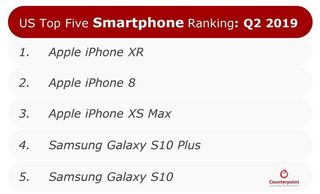2019 Q2 results show that Google and OnePlus are on the rise

What you need to know
- Phone sales in the U.S. are down 1.5% overall year-over-year in Q2 of 2019.
- The big winners were OnePlus and Google with growth of 152% for OnePlus and 88% for Google.
- However, the top five smartphones were still dominated by Apple and Samsung.
Phone sales have been declining for several quarters now, and the trend continued in Q2 of 2019. According to recent data published by Counterpoint Research, the U.S. saw a decline of 1.5% between Q2 of 2018 and Q2 of 2019.
However, it's not all bad news. Some manufacturers still gained ground while sales slowed for others. In particular, OnePlus saw a massive 152% increase year-over-year and Google saw an impressive 88% jump in the same time frame.
OnePlus owes its success to its new OnePlus 7 Pro, which helped tackle the high-end of the market at an affordable price. However, it wouldn't have been nearly as successful in the U.S. if not for OnePlus's partnership with T-Mobile.
For Google, it was able to increase sales after releasing its midrange masterpiece, the Pixel 3a, which gives you almost everything you'd want from the Pixel 3 lineup but at much more reasonable price.

Despite the rise of OnePlus and Google, neither of the two handset makers made it into the top five smartphones. That honor is split between Apple and Samsung, with Apple holding the top three spots and Samsung placing fourth and fifth.
One of the biggest surprises from the rankings, is that the second most popular iPhone was the iPhone 8 that was released almost two years ago. While Samsung placed fourth with its Galaxy S10 Plus and fifth with its Galaxy S10.
The data also shows that users are continuing to hold onto phones longer instead of upgrading. The big four carriers only saw an average upgrade rate of 4.5% with the majority of the holdouts being users that own more expensive flagship phones.
Be an expert in 5 minutes
Get the latest news from Android Central, your trusted companion in the world of Android
Overall, the data tracks with a concerning trend for makers of premium smartphones, where consumers are choosing to hold onto their phones for longer and are opting for more affordable upgrades when they do decide to purchase.

